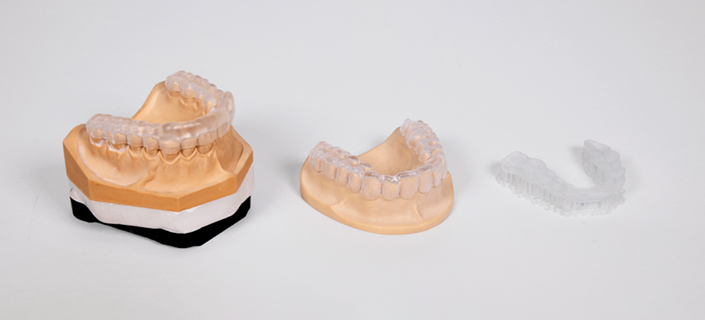In dental practice, the value of occlusal splints is manifested by their multiple therapeutic applications, which expand the boundaries of conventional treatment methods. These splints are instrumental in the treatment and prevention of a number of dental and orthodontic pathologies.
Bruxism: Occlusal splints play a central role in the treatment of bruxism, a condition that includes involuntary nighttime or diurnal tooth grinding and clenching activities. Their use effectively minimizes tooth damage by acting as a protective barrier between the rows of teeth. In addition, they help reduce muscle tension and jaw joint strain, which results in significant pain relief.
Temporomandibular joint disorders (TMJ disorders): Occlusal splints are proving to be indispensable in the management strategy of temporomandibular joint disorders. By redistributing chewing pressure and enabling optimized jaw joint positioning, they help relieve joint pain and improve joint function. Their use can also reduce accompanying symptoms such as headaches and tinnitus.
Craniomandibular dysfunction (CMD): Occlusal splints have been shown to be effective in CMD, a multifactorial disease that affects the jaw joint and masticatory muscles.
Craniomandibular dysfunction (TMD) is a complex disorder that encompasses a wide range of symptoms affecting the jaw joints, masticatory muscles and often adjacent structures. This disorder can cause a variety of symptoms, including TMJ pain, headaches, facial pain, restricted jaw movement, tinnitus and even a change in bite position .
CMD is multifactorial, which means that it can be triggered by a combination of different factors such as incorrect loading of the jaw joints, stress, misalignment of the teeth or jaw and muscle tension. The complexity of CMD makes an individual and holistic approach to diagnosis and treatment essential.
Occlusal splints play a crucial role in the treatment of TMD. They are designed to stabilize the bite and promote correct jaw positioning, thereby reducing the strain on the jaw joints and surrounding muscles. By distributing the chewing pressure evenly across the rows of teeth, they help to alleviate the symptoms of TMD and contribute to relaxing the chewing muscles.
The successful use of occlusal splints for TMD requires careful diagnosis and individual adjustment. An incorrectly adjusted splint can worsen symptoms or cause new problems. Therefore, close cooperation between dentists, orthodontists and, if necessary, other specialists is necessary to ensure optimal fit and functionality.
